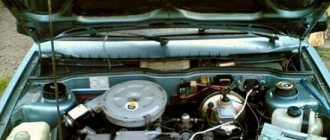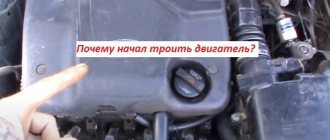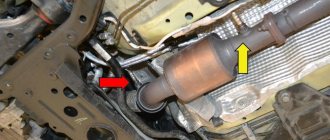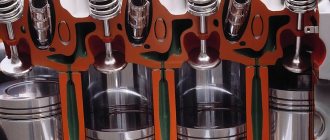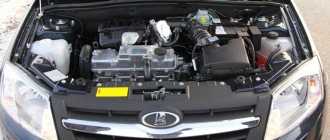The engine is tripping: what is it?
Many people have heard the expression “move troit,” but not everyone always understood what it meant. Kalina’s engine has 4 cylinders, when one of them refuses to work, it turns out that the engine starts working on only 3 cylinders, hence the expression that the internal combustion engine is tripled, that is, it works on 3 out of 4 cylinders.
If there are 6 cylinders in a car and one of them does not work, then it turns out that the engine is “triple”, but no one uses this expression, since many even when one of the cylinders fails in a 6-cylinder internal combustion engine they say that it is “triple” .
Similar problems
Other problems may also occur besides those described above. When the 8-valve engine on Kalina fails, the culprit of the problem may also be the ECU, which in this model is placed very poorly. If the owner did not wrap it with film, the contacts could oxidize, and conductivity through them could slow down or disappear altogether. The on-board computer will say the same, producing various errors.
Occasionally, it happens that antifreeze gradually seeps into the electronic control unit through a bunch of wires. Moreover, outwardly the ECU will look dry, although aggressive liquid gradually gets inside it. Therefore, the driver needs to open the block housing and inspect the contacts.
How to determine which cylinder is not working
To determine a non-functioning cylinder on a Lada Kalina, you can use two methods: computer diagnostics or hearing.
To determine a non-functioning cylinder using diagnostics, you need to connect a special scanner to the OBD connector and read readings from the operation of the internal combustion engine.
You can also determine a faulty cylinder by the sound of the engine; to do this, you need to remove the connectors from the ignition coils one by one and listen to the engine. For example, when the engine is revving, you need to remove the connector from the first ignition coil; if the engine speed starts to drop or the sound of the engine changes, then this cylinder is working, put the connector back in place and remove it from the second coil, and so on until, when removing the connector from ignition coils, the operation of the engine will not change, this will mean that this particular cylinder is not working at the moment.
Reason 1. The food was so-so
The author of the article had a breathtakingly funny story. True, not with him personally, but with a friend. He once filled up with fuel at a well-known gas station. I filled it up and went on a date with the girl. And it’s frosty, winter outside. While we sat in the cafe and cooed at the cinema, it’s time to go home. But there’s no way to get home – the car doesn’t move. Well, no way at all: we haven’t tried everything, we haven’t read what forums. And so, on the advice of an experienced person, my friend decided to stick a branch into the gas tank and check the gasoline. And what do you think? Gasoline is frozen! That is, in general! Apparently the brave mixers overdid it with water in the fuel. Of course, they drove the car away, warmed it up and drained the gasoline, but a residue remained.
Why does Kalina's engine stall?
There can be many reasons for the tripping of the Kalina engine, but they all fall into two groups: mechanical and electrical. Each of the groups has its own reasons that seriously affect the operation of the internal combustion engine; most often, the reasons for the failure of one of the cylinders are electrical breakdowns and, much less often, mechanical damage.
Let's look at each of the groups in more detail to delve a little deeper into this topic.
Electrical causes of internal combustion engine tripping
When the engine starts to stall, the first thing you need to do is pay attention to the electrical parts of the car involved in the distribution of spark and fuel.
List of details affecting the operation of the internal combustion engine and its tripling:
- Spark plug;
- Ignition coils;
- The engine control unit;
- Injectors;
Spark plug
To ignite the fuel mixture in the combustion chamber, spark plugs are used; they ignite the fuel at the moment of its compression. If a car has 4 cylinders, then there are also 4 spark plugs, when one of the spark plugs becomes dirty or fails (the insulator is damaged), then the cylinder in which this spark plug is located begins to work unstably or fails altogether.
Ignition coil
The ignition coil generates a high voltage that can create a powerful spark in the combustion chamber. It transmits this voltage to the spark plug, which produces a spark.
Coil of 8-valve internal combustion engine
In 8-valve engines, an ignition module is installed, which is responsible for the operation of all 4 cylinders; inside it there are two coils, divided into two cylinders. The first coil is responsible for the operation of cylinders 1-4, and the second for the operation of cylinders 2-3. When the ignition coil on an 8-valve engine breaks down, most often two cylinders fail at once, that is, the engine “doubles”.
Coils of a 16-valve internal combustion engine
On 16-valve internal combustion engines, each cylinder has an individual ignition coil, which is placed directly on the spark plug. This makes a total of 4 ignition coils.
Injectors
Injectors supply fuel to the engine combustion chamber; in Kalina there is one injector on each cylinder, which can fail due to contamination or electrical failure. When there is a spark at the plug, but the cylinder still does not fire, then the fuel injector is most likely to blame.
The engine control unit
The ECU has special keys that control each cylinder, a total of 4 keys. Due to exposure to high currents and high voltage, as well as short circuits, these keys can fail, thereby turning off any of the cylinders. An experienced electrician can fix such a breakdown by resoldering this key.
Mechanical causes of internal combustion engine tripping
In addition to common electrical problems, there may also be mechanical problems that cause engine vibration. As a rule, such problems are much more difficult to solve and even more expensive.
List of mechanical reasons affecting engine tripping:
- Valve compression or damage;
- CPG wear;
- Malfunction of hydraulic compensators;
- Air leak;
Let's look at each of the reasons in more detail.
Air leak
Air leaks
One of the most common mechanical damage is air leaks. Most often it occurs at the joints of the receiver or between the injectors. The problem is quite difficult to solve due to the need to dismantle many parts from the car, but financially it is very cheap.
Hydraulics malfunction
This problem occurs only on 16-valve Kalina engines. Initially, the compensator begins to knock harder and harder, which after some time leads to its complete breakdown and, therefore, the inability to open the valve, and this, consequently, will lead to the inoperability of one of the cylinders.
CPG wear
With high mileage on Kalina, the cylinder-piston group wears out, which leads to a significant decrease in compression up to improper engine operation and, of course, to possible tripling of the internal combustion engine.
Valve preload
Occurs only on 8-valve engines due to incorrect valve adjustment. Since the valves on such internal combustion engines are regulated by special washers, sometimes if the adjustment is incorrect, the valve can become jammed, and this will inevitably lead to the constant opening of the valve in any of the cylinders and, consequently, to a loss of compression in it.
Spark plug
A breakdown, contamination or failure of this element can lead to the car idling intermittently, or, in popular parlance, “triple”. To eliminate the problem, you need to unscrew the spark plugs. How to do it:
- Remove the negative terminal from the battery.
Removing the battery terminal
- We remove the tips of the high-voltage wires from the spark plugs.
We take out the high-voltage wires - Using a spark plug wrench or a long 21 socket, unscrew the spark plugs and remove them.
Removing spark plugs using a 21 socket
That's basically all the dismantling operations.
In order to understand the condition of the spark plug, you need to visually inspect it: if it is too dirty, it means that they are being filled with gasoline and it cannot detonate normally, but if it is too clean, then not enough fuel gets into the engine.
Also, it is imperative to check the performance of the spark plugs. This is done on a spark plug stand, but if there is no such thing, then the old fashioned way, using a tester, we measure the resistance. It is imperative to measure the spark plug gap using a feeler gauge with a mark of 0.10 - this is the standard size that should be on all elements.
Operating principle of the electronic gas pedal
Location of the electronic accelerator pedal in the interior of cars of the LADA KALINA family: 1 – electronic accelerator pedal
The throttle valve is controlled via an electronic pedal using two sensors that record changes in the position of the accelerator pedal (DPPA sensors). These are potentiometric resistors with a 3.3V from the controller. The DPPA is connected mechanically to the pedal drive using springs.
The principle of the electronic gas pedal is that the springs are mechanically affected by the accelerator pedal lever, and they in turn increase the pressure on the sensors, which transform it into an electrical signal sent to the controller, which, based on it, changes the position of the throttle valve.
The output voltage of the sensors depends on the force of pressing the accelerator pedal. If it is at rest, the signal of the first sensor should be 0.31-0.56V , and the signal of the second - 0.15-0.28V . When the pedal is pressed, the signals are respectively amplified to 1.9V and 0.95V .
Regardless of the current position of the pedal, the signal from the first sensor must have twice the power of the signal from the second.
Reason 4. The pressure is so pressure
Look at the manual and decide what pressure is typical for the car. Find the regulator on the line and see if it is leaking. The second reason is incorrect configuration. Excess pressure is generated in the system, which affects the non-standard behavior of the car. Arm yourself with an air pump to check: raise the pressure level to the required level and dump fuel into the tank. The operations must be performed simultaneously. If fuel reset occurs earlier, the regulator should be replaced.
If you have an injection engine, look for the fuel pump in the gasoline tank. With a carburetor engine, the pump is located directly on the engine, under the hood.
Distributor and capacitor
If the problem is in the capacitor on the distributor (and it can either fail completely or partially), then the engine will start and can operate properly and stably at idle speed. But while moving, the unit will twitch. This indicates a damaged capacitor. Remove the cover from the distributor, move the slider so that the contact opens. How is it checked? Turn the slider by hand to open the contact.
During the opening process, a spark should jump. If the capacitor is damaged, it will be blue and quite strong.




